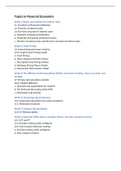Samenvatting
Summary All exam material from the lectures for Topics in Financial Economics
This summary includes all information relevant for the exam. It contains out of the lectures and additional remarks and explanations. There are also exam tips and exam question examples added in red which the lecturer gave during the lectures.
[Meer zien]




